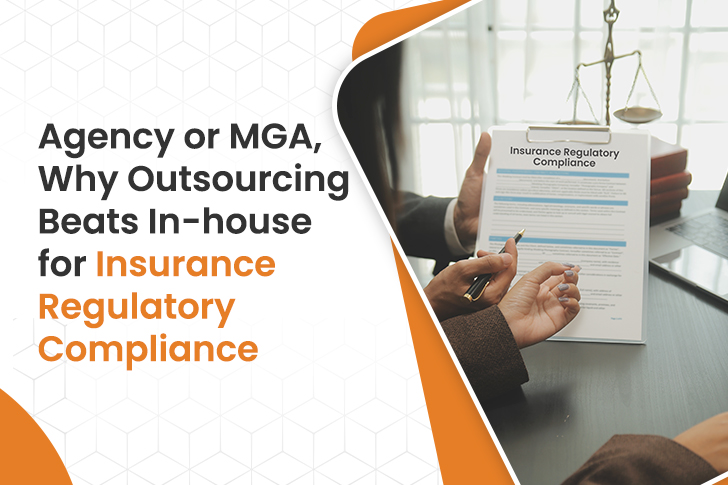With regulatory scrutiny and evolving compliance standards, the term Insurance Regulatory Compliance has become more than just a buzzword. It’s a lifeline that ensures the stability and integrity of the insurance industry. Given the complexities of state and federal regulations, international standards, and prevalent cyber threats, a robust and adaptable approach is vital to maintain compliance in your insurance company.
Compliance should always be a priority for insurers, as it is for regulators. According to a recent report by NAIC – The National Association of Insurance Commissioners, about 6,000 domestic insurers in the U.S. state insurance departments conducted 1,474 financial and market related exams. Nearly 25% of all carriers underwent an exam, resulting in states collecting close to $208 million in fines and penalties.
This blog post addresses the complexities of insurance regulatory compliance, equipping you with the knowledge and tools to navigate this complex terrain confidently.
What is Insurance Compliance, and Why It Matters?
At its core, insurance regulatory compliance refers to the internal controls, processes, and procedures your company implements to manage risk associated with adhering to regulations. These regulations are meant to protect both consumers and the overall insurance market by establishing guidelines on how insurance companies should operate. They cover everything from consumer data protection and anti-money laundering (AML) practices to licensing requirements and dispute resolution procedures.
Compliance in Insurance: Navigating State, Federal, and International Standards
Insurance regulatory compliance is a multi-layered challenge, demanding awareness of regulations at various levels:
- State Regulations: The McCarran-Ferguson Act grants states primary authority over insurance regulations within their borders. Each state has its own insurance department that sets specific rules and licensing requirements.
- National Association of Insurance Commissioners (NAIC): This influential organization develops model laws and best practices that states can adopt, fostering some degree of national uniformity.
- International Association of Insurance Supervisors (IAIS): This global body establishes international standards for the insurance sector, aiming to promote fairness and security across jurisdictions.
Understanding which regulations apply to your company and how they interact is crucial for effective compliance.
How Insurance Regulatory Compliance Standards Are Formed?
- Regulatory compliance standards are generally formed in alliance with the National Association of Insurance Commissioners (NAIC), with guidance from the U.S. Department of the Treasury and the Federal Insurance Office (FIO). However, the FIO is not a regulatory agency; instead, it monitors all aspects of the insurance sector, including identifying potential systemic risks and the accessibility of affordable insurance products in underserved communities.
- The Office of Foreign Assets Control (OFAC) also plays a crucial role in insurance regulatory compliance. OFAC ensures that brokers, agents, insurers, and reinsurers comply with regulations to prevent dealings with oppressive governments, narcotics traffickers, terrorists, and other threats to national security. Failure to comply with OFAC regulations can result in severe civil and criminal penalties.
- At the international level, the International Association of Insurance Supervisors (IAIS) and the Financial Stability Board (FSB) work towards developing strong regulatory, supervisory, and other financial sector policies. These international bodies aim to strengthen financial systems and accelerate the stability of international financial markets.
Insurance Industry Regulatory Compliance
Compliance in the insurance industry can be complex due to the different rules that apply based on jurisdiction, product offerings, and more. State and federal laws, as well as international standards, need to be considered.
The insurance industry has two main facets of compliance: consumer data protection and anti-money laundering (AML) regulations. Both are equally important in maintaining compliance in the insurance industry.
Building a Solid Foundation: Steps to Effective Compliance
Developing a robust insurance regulatory compliance program requires a multi-pronged approach:
- Set the Tone from the Top: Compliance should be an organization-wide priority, not just a risk and compliance team concern. Leadership must master a culture of compliance involving stakeholders from all departments.
- Identify and Assess Risks: Conduct a thorough analysis of your compliance obligations and potential non-compliance risks. Understanding the applicable regulations and your company’s specific vulnerabilities is crucial.
- Compartmentalize Different Types of Compliance: Address consumer data protection and AML regulations separately, tailoring your approach to each. Consider dedicated teams or a solution that facilitates managing both effectively.
- Establish a Clear and Accessible Policy: Develop a comprehensive compliance policy outlining your company’s principles, processes, and procedures. Make it readily available for all staff and regularly review it to ensure everyone understands their responsibilities.
- Leverage Technology: AML compliance management solutions can streamline workflows, automate tasks, and improve efficiency. They can also help generate reports and ensure proper documentation for regulatory audits.
- Stay Updated and Adapt: Compliance regulations are constantly evolving. Regularly review your program and procedures to ensure you adapt to changes and remain up-to-date with the latest requirements.
Insurance regulatory compliance is an ongoing journey, not a one-time destination. By understanding the importance of compliance, navigating the regulatory landscape, and taking proactive steps to build a robust program, you can confidently empower your insurance company to navigate the future and mitigate non-compliance risks.
Do you still want to know more about compliance in insurance or need backend support to navigate these ever-changing waters of insurance industry regulatory compliance? At Insurance Back Office Pro, we provide expert backend services for insurance regulatory compliance tailored to the unique needs of Agencies, MGA, and Carriers.
With eight global delivery centers and round-the-clock support, we are equipped to help you achieve and maintain compliance, alleviating your burdens and allowing you to focus on your core business objectives. Contact us today to start your journey toward efficient regulatory compliance.



